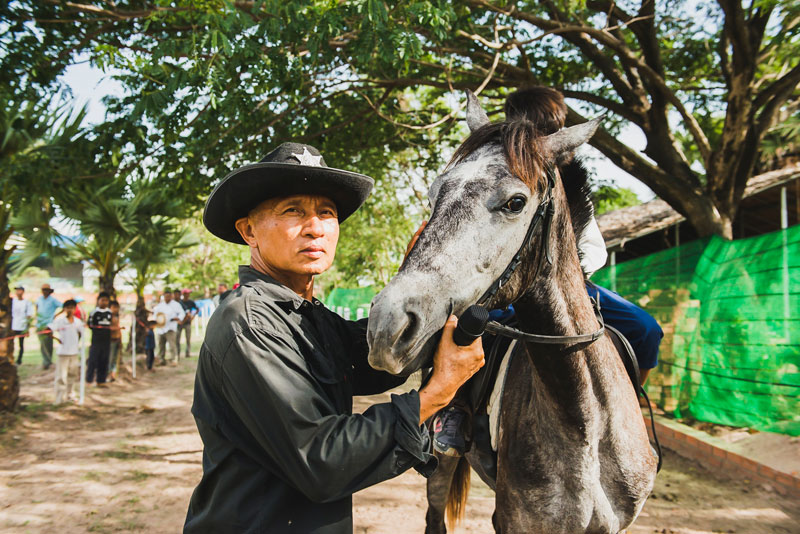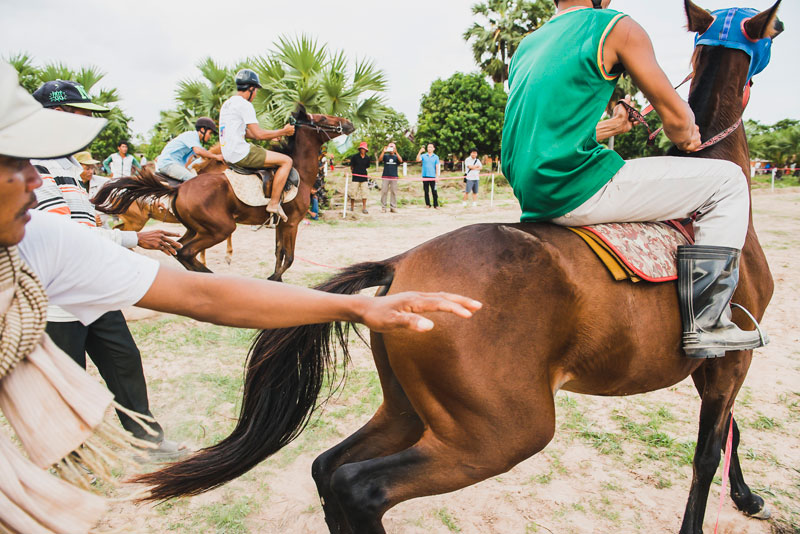They call horse racing the sport of kings.
Every Saturday—in Melbourne and Macau, in Dublin and Dubai—the rich and famous head to manicured tracks, drink champagne and pose for the social pages, while supreme athletes and horses with Porsche price tags chase million-dollar purses.

Judges examine every horse, every race, the fluctuating weights of jockeys, track conditions, weather reports and photos of the finish to satisfy the sponsors and gamblers who support a multibillion-dollar industry that spans the globe.
In Cambodia, a self-styled cowboy with a vision and a sheriff’s hat wants in on the action.
“It’s my dream,” said Keo Vannarin, a 49-year-old who has retired from a life of NGO work to focus on his own ambitious projects.
“I have 200 hectares in Kompong Chhnang where I will build a modern racing center that can bring people from Phnom Penh, from all over Cambodia. An international race track that will attract horses from overseas,” he said.
“We can see that the people are interested.”
On a plot of sandy land in the far northern reaches of Phnom Penh last Saturday, Mr. Vannarin took something like a full stride toward his dream.
A few hundred locals, a smattering of expatriates and eight ponies turned out for the Cambodian Equestrian Center’s launch in Prek Pnov district—an informal three-race program during which only some of the jockeys wore shoes, nobody sipped bubbly and, true to the spirit of racetracks around the world, all manner of strange and interesting characters turned up.
“This is my horse, Pimousse,” said Guilleme Larivain, a 51-year-old French horseman who operates a trail-riding venture out of Akrei Khsat, across the Mekong River from Phnom Penh.
“In France, Pimousse is a small candy with big flavor. The message from my horse is that I am small, but I have a lot of temper,” Mr. Larivain said, his excitement growing as the first three horses—healthy but half the size of those in countries where racing is an obsession—moved to the starting line.
“I told my riders: Just be safe, don’t worry about winning. Let’s see what happens,” he said.

A 3-2-1 countdown and chorus of “yahoos” rang out as a gray horse named Spirit sprung into a full gallop as its competitors, Sambo and Dany, trotted along leisurely in the dust.
“What is this, what are they doing?” called Rinda Nop, who holds a degree in veterinary science, making him the race-starter and the track’s chief steward.
“This is not a warm up. I don’t want them to warm up. It is warm a lot already,” Mr. Nop said, a walkie-talkie in one hand, a bullhorn in the other. “This is not good. Next time, I will make a rule.”
Following a restart, Sambo, from the Akrei Khsat stable of Mr. Larivain, scorched around the track, winning by half the length of the 150-meter straight as Dany’s rider slipped down the side of his horse on the final bend. Spirit, his energy spent, foundered in the sun.
Whichever way they looked, members of the crowd were greatly amused.
Half an hour later, the second race turned out to be a farce: A one-on-one duel between Hino, a well-presented chestnut male with the head-carriage of a true racehorse, and Chhaya, a small, grey pit pony missing an eye and the desire to run.
Chhaya stopped his run halfway around the track and then tiptoed in confused circles until he was led away from the track and retired for the day. Hino was the victor by default.

Mr. Nop, a project manager at the Cambodian Pony Welfare Organization, said he would review the inclusion of Chhaya in the day’s events.
“If they do bad welfare, I will not allow them to participate,” he said of the trainers and jockeys. “We will check.”
The third race brought Pimousse to the start, along with Sangha and Thida, two well-fed ponies from Mr. Vannarin’s own stable in Kompong Chhnang.
“My Pimousse is mighty,” Mr. Larivain said as the trio shuffled around at the start line, agitated by the heat and attention. “But he has one problem for racing: He never wants to be first. He is more comfortable having another horse in front of him. He is a follower, a ‘second’ horse.”
In the hardest fought race of the day, Thida was squeezed off the track, spearing through a light rail into an adjacent plot of land, where she chose to graze on a rare patch of green grass, leaving Pimousse and Sangha to duel.
True to form, Pimousse lacked resolve with the finish in sight, refusing to go past the bigger horse as its rider dropped his reins and broke into a celebratory dance, charging to the line in front of the hollering locals who had dropped by to take in this unusual scene.
“It’s not the strangest [thing] that has happened in our village, but it is the most excitement,” said Keo Chanthou, a 44-year-old fruit-seller who closed her stall and walked to the sandy lot with a group of giddy children in tow.
“If he can dance with his arms [while] he is driving the horse, it is special,” she said. “We have always had the horses here, but only to carry [goods], not to run really fast like this.”

As the sun began to dip on a day of dust and fun, the three winning horses were brought back to the start line to duke it out once more. From Sambo, the day’s biggest winner, Sangha, with its dancing jockey, and Hino, the closest thing to a real racehorse, a champion had to be found. And its rider would pocket a $30 prize.
At professional race tracks, horses never run twice in one day. At the Cambodian Equestrian Center’s first ever race meeting, however, the work had been tripled for some, with the final contest a two-lap affair.
Though not everyone was aware.
As the horses completed the first lap in the final race, with Sangha well clear of the rest, its rider again dropped the reins and began to celebrate, allowing Sambo, from Akrei Khsat, to take the lead.
With half the crowd jeering and the other half in raptures, the dancing jockey realized his mistake and began to once again drive his horse forward—steering his mount through an entire lap without once again taking the reins—but it was too late. Sambo had taken an unassailable lead and his jockey had stolen the cash.
“Am I surprised? Yes, I am surprised,” said Mr. Lavirain, the victorious trainer, grinning widely.
“These are my slow horses. But the advantage we have here is some classical training. You could see, many of the other horses, they were easily distracted. They stopped to eat grass. They slowed down when they passed the stables because they wanted to say hello to their friends,” he said.

The spectators began filing out of the lot about as soon as horses crossed the finish line in the final race: Whether they had been converted into full-fledged fans remained to be seen.
For Mr. Vannarin, the self-styled cowboy whose race-day attire fell somewhere between farmhand and fresh fashion, the plan to put Cambodian horse racing on par with the rest of the world is just beginning to unfold.
From his days working for Untac in the 1990s, Mr. Vannarin said he had accumulated vast property holdings across the country and was willing to sell off plots of land as required to fund his dream—a dream that he said began forming when he first saw a horse in the hills of Perpignan in the south of France.
“I was just a political refugee then, adopted by a French family, so I was not able to touch the horses,” he said. “But my time in France allowed me to get an education.”
With a masters degree in information technology, Mr. Vannarin said he developed a program that allowed Cambodia’s donors to track the results of their philanthropy, and that he was put on the Untac payroll as an IT advisor.
“Do you know how much they pay?” he said. “And they pay all expenses. I was able to buy land every month. I am a very lucky man.”

While he has sold off much of that land to fund his retirement—and an array of agricultural projects intended to support his horse racing dream—his jewel remains the 200 hectares in Kompong Chhnang’s Boribor district.
“Historically, Cambodians love horses,” he said when asked why he thought his project could be a success. “The top military, the ancient Khmer, kings—they all loved horses,” he said. “And in 1956, Cambodia competed in equestrian at [the] Stockholm [Olympics].”
In the clusters of horses and horsemen in the provinces of Siem Reap, Kompong Cham and Kandal, as well as in Vietnam, Mr. Vannarin sees the ingredients to rekindle in Cambodia a lost love of horses that mirrors his own.
“King Norodom Sihanouk, he also loved horses. He was a cavalier, too,” he said.
And the chances of attracting the current head of state, King Norodom Sihamoni, to the heart of the country for the Cambodian Equestrian Center’s first international races—hopefully in 2017?
“Oh we would need to make a lot of progress,” he said. “But we are working hard and, if it’s the sport of kings, why not?”



